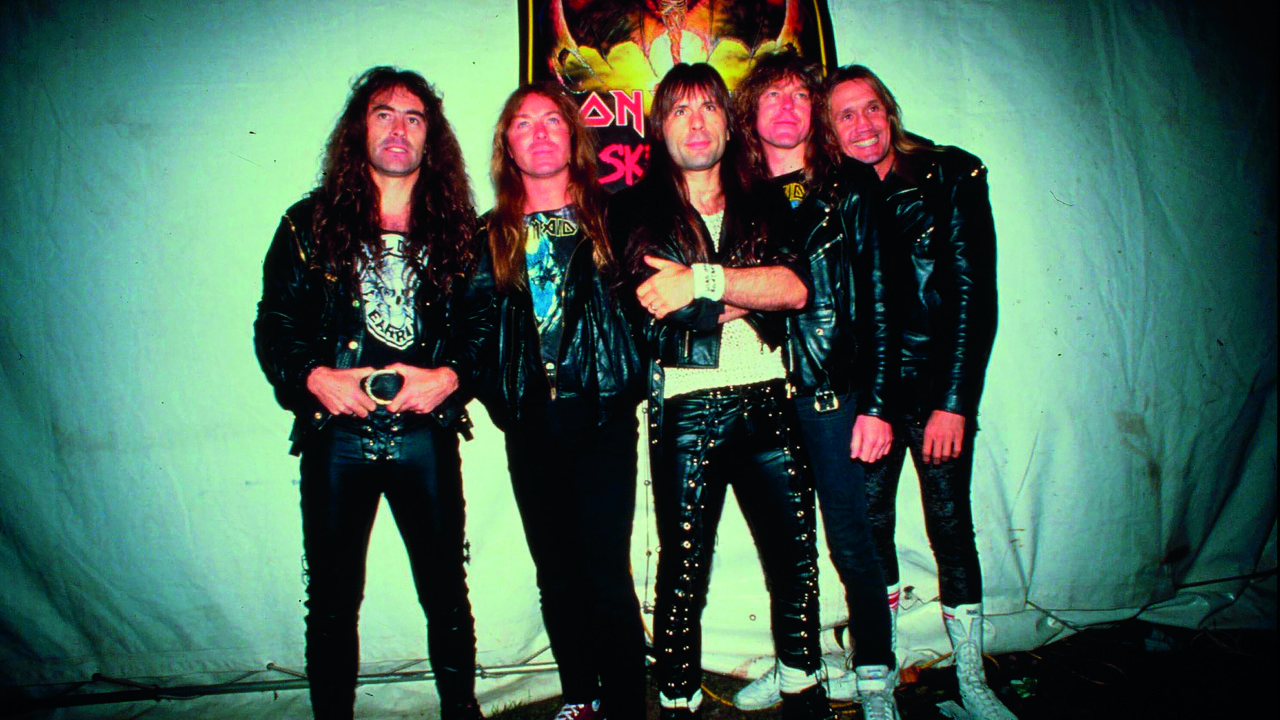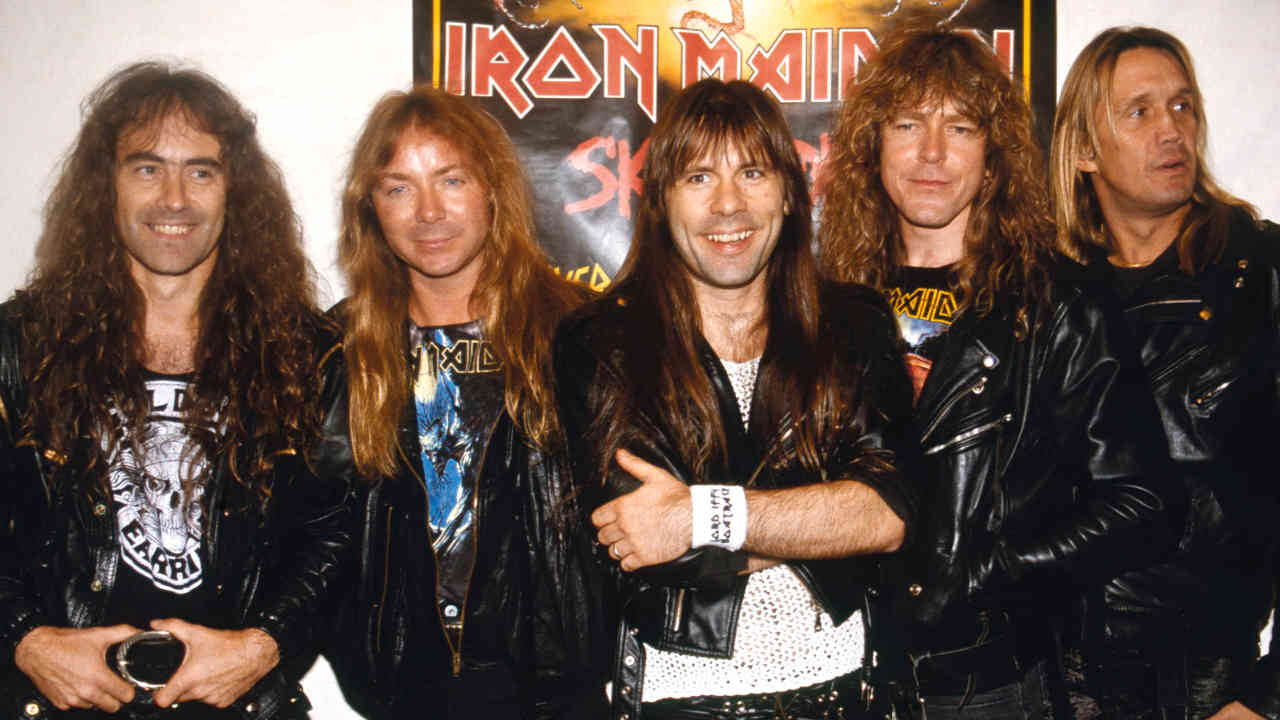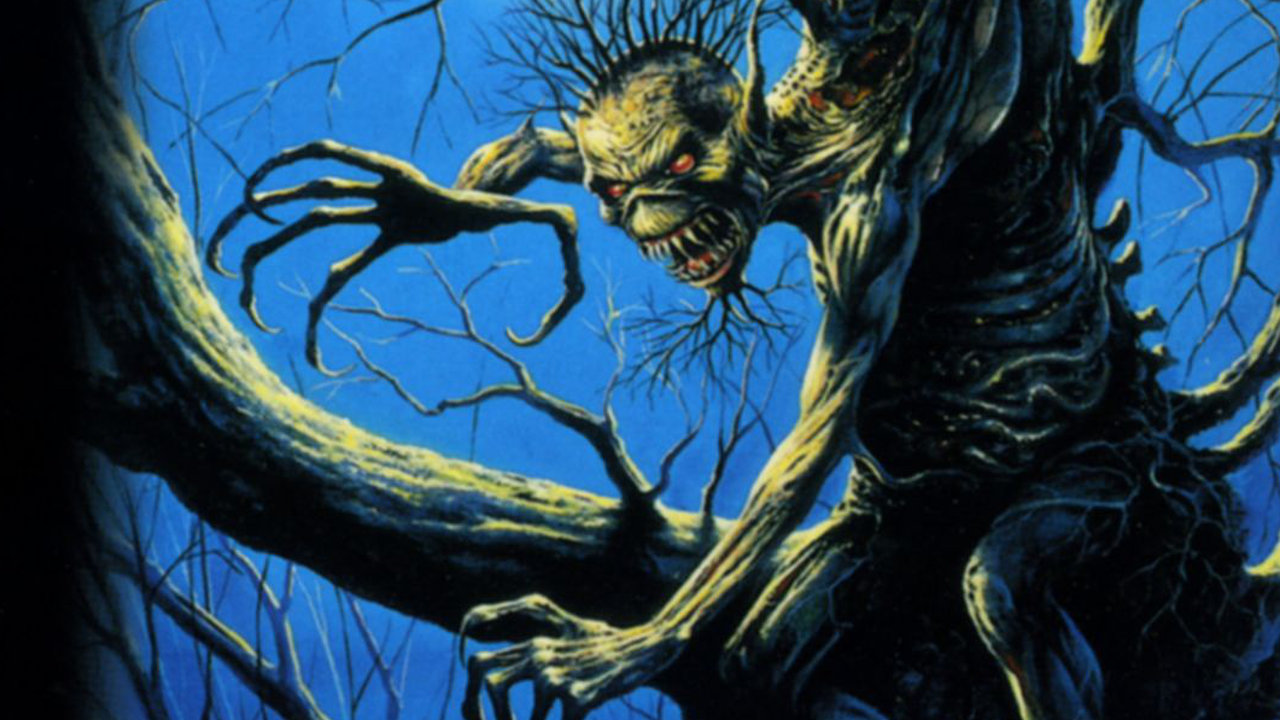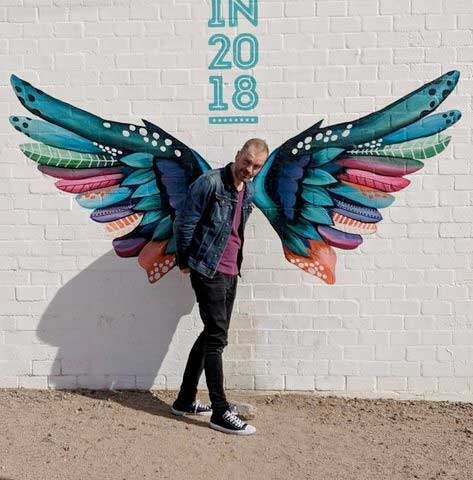On August 28, 1993, the decapitated head of Bruce Dickinson was shoved onto a metal spike in front of several hundred Iron Maiden fans by the band’s deathless mascot, Eddie.
The symbolism was hard to miss. This wasn’t just the climax of the final show on the tour in support of the previous year’s Fear Of The Dark album, it was also the last show of the singer’s 12- year tenure with the metal icons.
The gig was being filmed at Pinewood Studios near London for an MTV special titled Raising Hell. It was part rock concert, part magic show – the latter courtesy of illusionist Simon Drake, who provided suitably schlocky interludes involving audience members being burned alive in coffins and semi-naked women having their hearts torn out while tied to a rack.
The gory finale, involving Bruce being shoved in a ‘iron maiden’ torture device before Eddie lumbered out to separate the singer’s ‘head’ from his body, was the culmination of a journey that had begun several months earlier, with Bruce’s realisation that he no longer wanted to be the singer in one of the world’s biggest metal bands.
Speaking to US TV journalist Charlie Rose in 2017, the singer laid out his reasons for leaving. “I was having my little artistic dark night of the soul,” he said. “I was thinking, ‘I am in an institution, and I will die in this institution if I don’t do something about it.’”
His decision was as unexpected as it was drastic. Fear Of The Dark hadn’t just righted the Iron Maiden ship after an uncharacteristically wobbly period, it had updated their musical and lyrical approach, jettisoning some of the musical excesses of the past and bringing the band more in line with changing contemporary musical tastes. Maiden’s career didn’t exactly need saving, but Fear Of The Dark had set them up for a new decade.
Now everything was in turmoil.

Maiden started the 1990s in an unfamiliar position: with their backs against the wall. 1988’s Seventh Son Of A Seventh Son was heavy on proto-prog metal epics, and the band’s first headline appearance at the Monsters Of Rock festival and subsequent tour had seen the East London quintet playing in front of an impressive wall of fake icebergs. But as the new decade dawned, those kind of musical and visual excesses were starting to feel outdated.
That problem, as bassist Steve Harris saw it, would be easy enough to solve: they would go back to basics. Maiden’s commander-in-chief had recently converted a barn on his Essex estate into a studio, christening it Barnyard Studios, and the band would convene there to record a new album that stripped away the flab.
Their plans were thrown into chaos when guitarist Adrian Smith left the band just before they were due to start recording. He had become increasingly unhappy with life in Iron Maiden, and the decision to record in Steve Harris’s barn was the final straw. “Adrian wasn’t fired, but he didn’t quit entirely willingly,” Bruce Dickinson later said.
“Bruce was bored out of his brains, that much was obvious.”
Steve Harris
There was a ready-made replacement at hand. Hartlepool-born guitarist Janick Gers was a veteran of the 80s rock scene, and had appeared on Bruce Dickinson’s debut solo album, Tattooed Millionaire, released in May 1990.
Unfortunately, Maiden’s first album of the 90s was underwhelming. Released in October 1990, No Prayer For The Dying lacked fire and energy. Even longtime Maiden artist Derek Riggs’ cover seemed uninspired - Eddie bursting out of a grave had been done bigger and better on 1985’s Live After Death.
“No Prayer For The Dying was a huge backwards step,” Bruce later acknowledged. “The fact is that it sounded terrible.”
The album didn’t impact drastically on Maiden’s career, though its chart positions in the UK and US were lower than its predecessor (No.2 and No.17 respectively, compared to No.1 and No.12 for Seventh Son…). Steve Harris, ever the staunch defender of all things Maiden, refused to acknowledge any significant dip in quality.
“The album surprised quite a lot of people, but there are a few good things on it,” he told a French magazine in 1996. “I don’t really have many good memories of the tour, though. Bruce was bored out of his brains, that much was obvious.”
“When Bruce came back from his solo tour, in 1990, I realised then that he didn’t have the same fire onstage with Maiden as he did with his own band,” said Steve. “It seemed like he was going through the motions a bit. So I asked him, ‘Are you still happy? And he assured us that he was totally, 100% still there.”
Bruce Dickinson may have been all-in on Iron Maiden for now, but he knew something still needed to change for the band to regain the ground they’d lost with No Prayer For The Dying. Metallica’s The Black Album, Nirvana’s Nevermind and Soundgarden’s Badmotorfinger had been released within a two-month period in the autumn of 1991, instantly reshaping the rock landscape and leaving Maiden in danger of becoming irrelevant, Bruce Dickinson feared.
“I was starting to think, ‘Well, I’d better have a serious word with the chaps, and find out how far they are prepared to go to take a chance with the band’s reputation in order to try and do something artistically that’s really, really new,’” Bruce told Metal Hammer in 1992. “So I had big chats with Nicko [McBrain, drums] and with Dave [Murray, guitar] and Janick and everybody, basically just playing devil’s advocate the whole time, saying the world is really changing – not like a bit, but a lot.”
Getting Iron Maiden to change overnight was like trying to pull a handbrake turn in an oil tanker. Despite the disappointment from some quarters at the way No Prayer For The Dying had turned out, Steve Harris was adamant that the band record the follow-up in Barnyard Studios too, this time with Martin Birch as co-producer.
Happily, Maiden’s new songs were better. Breathless opener Be Quick Or Be Dead – co-written by Bruce and Janick – captured the energy of vintage Maiden, but drew its inspiration not from fantasy, history or the supernatural but from current hot-button news subjects – in this instance, corporate corruption in general and recently deceased media tycoon Robert Maxwell in particular.
The singer’s attempt to drag Maiden into the 1990s was further evident on Fear Is The Key, which addressed the public’s hypocritical reaction to the AIDS epidemic. It had partly been inspired by the death of Queen frontman Freddie Mercury in November 1991. “There’s a line that goes, ‘Nobody cares ’til somebody famous dies’,” Bruce told Hard Force magazine. “As long as the virus was confined to homosexuals or drug-addicts, nobody gave a shit. It’s only when celebrities started to die that the masses began to feel concerned.”
Another Dickinson/Gers song, Wasting Love, could be viewed as a companion piece of sorts. “It’s about those who jump from one bed into another, those who sleep with whoever comes their way, without giving or receiving whatever they’re looking for, because they are very lonely,” said Bruce of the song. The slowburning track was the closest Maiden had come to writing a ballad since 1980’s Remember Tomorrow.
Even Steve Harris was updating his approach. The bassist’s Afraid To Shoot Strangers was a seven-minute, prog-tinged anthem inspired by the first Gulf War, which had taken place at the beginning of 1991. The song centred around the dilemma faced by a soldier who doesn’t want to kill enemy soldiers, but knows he has to or someone could kill him.
Afraid To Shoot Strangers was one of only two songs on Fear Of The Dark that called back to past Maiden epics. The other was the title track: seven minutes of building malevolence reputedly inspired by the bassist’s own nyctophobia that would instantly become a live favourite and remain a staple of the band’s set to this day.
Of course, Maiden were too savvy to throw the baby out with the bathwater. The album was bulked out with tracks that wouldn’t have sounded out of place on their earlier albums. Some were great (The Fugitive, the Charlotte The Harlot-referencing From Here To Eternity), some less so – The Apparition was forgettable at best, while the woeful football hooligan anthem Weekend Warrior was more Vauxhall Conference than Premier League.
Tellingly, Bruce and Steve didn’t write any new songs together. The bassist put it down to circumstances, but it meant there was little room for this pair of alpha dogs to iron out any issues that were brewing.
In interviews at least, Bruce was in full cheerleader mode. Fear Of The Dark, he insisted, was the album that would reposition Maiden as a vital force for the 1990s, a band that could go hold their own with the younger acts they had inspired.
“There’s a break between Fear Of The Dark and the old Maiden albums,” he told Hard Force magazine in 1992. “I really believe that it will make a huge impact, we’re going straight into the 90s, this time. When they’ll listen to it, I hope they say, ‘We thought that the last Metallica was good, but check this out, now!’”

Fear Of The Dark was released on May 11, 1992. The idea that this was the start of a new era for Maiden was underlined by the cover. In a major break with tradition, the band’s management invited artists to submit illustrations for the album sleeve – until that point the sole preserve of Derek Riggs, who had created Eddie and whose artwork had adorned every Maiden cover since their debut single, Running Free.
The image they opted to go with came from illustrator Melvyn Grant, who reimagined Eddie as a feral forest-spirit glaring malevolently from the bough of a tree as a full moon hung in the sky behind him. They didn’t completely dispense with the services of Derek Riggs – one of his illustrations graced the cover of the album’s first single, Be Quick Or Be Dead, but that would be the last time his artwork appeared on any Iron Maiden sleeve.
These musical and visual shifts didn’t harm the album’s chart positions. It returned Maiden to No.1 in the UK charts, and reached No.12 in the US. The subsequent tour, too, was a success. It included their second headlining show at the Monsters Of Rock festival at Castle Donington, four years after their first. That gig featured a guest appearance from Adrian Smith during the encore of Running Free, a fleeting glimpse of the three-guitar line-up that Maiden would employ in the 21st century.
Significantly, it also included five dates in South America (a sixth, in Chile, was cancelled due to pressure from religious groups). Maiden had played a one-off show in Brazil at 1985’s Rock In Rio festival, but this was the first time they’d properly toured the continent. The rabid reception that greeted them showed there was life beyond North America, Europe and Japan.
The first leg of the Fear Of The Dark tour ended in November 1992, after which Bruce Dickinson flew to Los Angeles to work on a second solo album, but something was nagging at him. He’d tried to raise his concerns during the tour about Maiden’s unwillingness to address what the singer saw as the band’s flaws.
“Everyone looked at me as if I had lost my mind,” he wrote in his 2017 autobiography, What Does This Button Do?. “Maybe I had, or maybe we were on the slow trajectory to a luxurious creative extinction.”
"Everyone looked at me as if I had lost my mind"
Bruce Dickinson
It was while he was in Los Angeles that he picked up a copy of the LA Times that was lying on the floor. Flicking through it, he came across the Quote Of The Day section, featuring an epigram from the 19th-century author Henry James: “All growth is a leap in the dark, a spontaneous unpremeditated act without the benefit of experience.”
The quote resonated with him on a deep level. “At that moment, I decided to leave Iron Maiden,” he recalled.
Stepping away from one of the world’s biggest metal bands was easier said than done. He had to inform his bandmates, of course, but Maiden’s stalwart manager Rod Smallwood was due to visit Bruce in the studio imminently, and it made sense for the singer to inform him first.
“I said, ‘I’ve got some good news and some bad news,’” Bruce told the manager. “The bad news is that I feel I have to leave the band, so I thought I’d tell you first. The good news is now you have a whole new solo artist to manage.
The singer offered to tell Steve Harris himself, but Smallwood blocked that suggestion. “I’m sure his mind was already spinning damage limitation and making plans to avoid rock’n’roll Chernobyl in the media.”
One complicating factor was that Maiden were due to kick off the second leg of the Fear Of The Dark tour in March 1993. Bruce agreed to honour his commitments, though Steve Harris later claimed that the rest of the band only found out about his decision relatively late in the day.
“I said, ‘How can we go out and tour and look people in the eye and know there’s someone up there that doesn’t want to be there?’” the bassist said in Iron Maiden’s official biography, Run To The Hills, in 1999. “
But Rod said, ‘He says he’s up for doing it and he’s just gonna leave at the end, and it’ll be like a nice sort of finale,’ and all that. And I said, ‘OK. If it’s taken in that light, then that’s OK.’ Of course, I totally regret it now.”
The Iron Maiden that kicked off the Real Live Tour on March 25, 1993 in Faro, Portugal were in a peculiar position: a major band playing a high-profile tour with a singer who wanted out. Publicly, both parties adopted a grin-and-bear-it approach. Behind the scenes, though, things were less than rosy. Tensions quickly grew as the tour progressed. Steve claimed the singer would step up to the plate at key shows, but phone it in when the stakes weren’t as high.
“He may as well have not turned up at all some nights,” Steve said in Run To The Hills. “And that’s when we all really began to feel bitterly towards him. Not because he was leaving, but because he really fucked that last tour up for us by not giving it everything he could have, which he promised us he would.” The bassist later expressed a desire to “kill” the singer for his alleged behaviour.
"As far as I’m concerned, I thought a band was a collective thing.”
Bruce Dickinson
The private acrimony occasionally spilled out into public. When an English journalist asked Nicko McBrain if their singer had “shat” on his soon-to-be-ex bandmates, the drummer couldn’t contain his anger.
“He’s fucking leaving the band, you dipshit!” he ranted. “He’s said, ‘Fuck you, I’m off!’ If that ain’t shitting on you then what the fuck is?”
“Everybody was saying how sad it was, but by then we couldn’t wait to get rid of the guy, to be brutally honest with you,” Nicko admitted in Run To The Hills. “We just wanted to get it over with.”
Bruce gave one final interview as a member of Iron Maiden on the day of the Raising Hell show. Speaking to French magazine Rock Hard, he made his disillusionment at the state of contemporary rock and metal scene clear. “They’re not really interesting anymore,” he said of traditional rock gigs. “Rave parties are exactly what the rock concerts represented in the 1970s,” he said. “That’s where you find drugs, girls and the freedom to react the way you really want.”
He also found time to get in one last dig at his bandmates.
“Steve is Iron Maiden,” he said. ‘It’s his thing, his creature, nobody else but him can claim the tiniest part of the band. He’s got his own recording studio, makes us rehearse and record the albums at his place. The other members of the band are delighted to work in such conditions, good for them. As far as I’m concerned, I thought a band was a collective thing.”
The aftermath of Bruce’s departure was predictably bitter. Both sides took jabs at the other in the press: Bruce wrote Maiden off as outdated and Steve Harris as dictatorial, Steve all but called the singer a traitor for leaving in the manner he did.
The weight of Bruce’s history with Maiden didn’t necessarily mean he was guaranteed success as a solo star, and so it proved. His first two post-Maiden albums, 1994’s Balls To Picasso and 1996’s Skunkworks, touched on everything from funk rock to Soundgarden-inspired quasi-grunge, but the public was unconvinced. Even a shift back to more familiar territory with 1997’s Accident Of Birth did little to restore his profile to pre-split levels.
Maiden themselves didn’t fare much better. The X Factor and Virtual XI, the albums they recorded with Bruce’s replacement, former Wolfsbane singer Blaze Bayley, were laboured and uninspiring. When the inevitable happened and Bruce Dickinson rejoined Maiden in 1999 – bringing Adrian Smith back with him – their fans breathed a collective sigh of relief. Not least because the singer came across as a man with his hunger renewed.
“I don’t want to equal people’s expectations,” he stated, “I want to exceed them. This band is far better now than it was at its supposed peak… We’re going to be unstoppable.”
And what of Fear Of The Dark 30 years on? While it’s nowhere near as beloved as classic collections such as The Number Of The Beast or Powerslave, it stands as a pivotal album for the band – a valiant attempt to navigate a changing world that would ultimately be overshadowed by subsequent events. It was the record Iron Maiden had to make to move forwards.
Iron Maiden's latest album, Senjutsu, is out now via Parlophone

